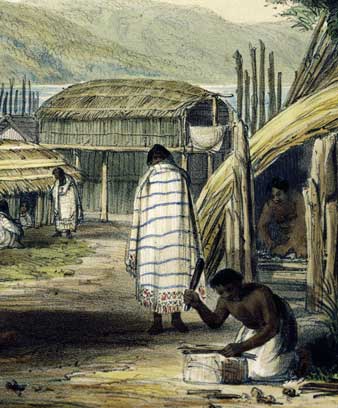Story summary
Related tribes
The Te Āti Awa people who settled in the area of Te Whanganui-a-Tara (Wellington Harbour) are closely connected to two other tribes: Te Āti Awa of Taranaki and Ngāti Awa of the Bay of Plenty and the far north. All three are descended from Awanuiarangi, whose mother was Rongoueroa. Tradition says that Awanuiarangi’s father was a spirit, Tamarau.
Te Whanganui-a-Tara
Rongoueroa was also the mother of Whātonga, whose father was Ruarangi. Ruarangi’s father was the Polynesian explorer Toi. Whātonga’s son Tara is remembered in the place name Te Whanganui-a-Tara (the great harbour of Tara).
Taranaki origins
Between the 1820s and 1835, people of the Te Āti Awa tribe migrated to the Wellington region from Taranaki. They were forced to move south because of raids by northern tribes, particularly the Waikato people. The Ngāti Toa people were also pushed out of Kāwhia by the Waikato tribes.
Migrations
Te Āti Awa moved south to Wellington in four migrations, or heke:
- Te Heke Tātaramoa, about 1822
- Te Heke Nihoputa, about 1824
- Te Heke Tamateuaua, in 1832
- Te Heke Paukena, in 1834.
Other tribes in Wellington
Te Āti Awa were not the only Taranaki tribe to move south. The people of Ngāti Mutunga and Ngāti Tama also settled the Kāpiti Coast and Wellington region. In 1835, when Ngāti Mutunga and some Ngāti Tama migrated to the Chatham Islands, their land around the harbour was given to Te Āti Awa and other Taranaki chiefs.
The impact of Europeans
In 1839 land in the Wellington area was bought by Europeans, a town was planned, and settlers began to arrive in 1840. As a result, Māori were forced to move outside the town. Many returned to Taranaki, but after the First World War they started moving back to Wellington to find work.
Te Āti Awa of Wellington today
In 1977 the Wellington Tenths Trust was established. It represents the descendants of Te Āti Awa and other Taranaki people who lived in the Wellington area before European settlement. The trust administers the lands given to Māori in the purchase of Wellington.
In the 2013 census, more than 2,500 people said they were descended from Te Āti Awa of Wellington.





